If you’re a flickr friend, you’ve already seen this. Otherwise, luxuriate in the overwhelming cute:
The new lambs officially have names.
Presenting: Ronnette Wigglesworth (aka Ronnie Wiggles) and Hokey Pokey. These were taken at just under 2 weeks.

Ronnie as an almost completely black merino ewe lamb. She’s still way smaller than her brother, but is just as frisky.

Hokey Pokey is Ronnie’s big brother, a spotted merino ram lamb who looks like a tiny cow. So far, his quarter inch of fleece has a much denser crimp than his sister’s quarter inch of fleece.

Here’s the whole family. You may notice that Agnes looks a lot different. Last Monday was shearing day!
It was drizzly on Sunday, and the weather was supposed to be rainy and snowy and awful Sunday night & Monday morning, so we were worried the sheep would be too wet to shear, but although it was cold and windy, it was dry and sunny, and all the wind Sunday afternoon meant the fleece had no lingering moisture.
Marilyn (that’s her looking adorable with Agnes) came out to help and see the lambs, and Kevin, Laura & Dave came to see the baby lambs, too. The sheepies gave me lots of beautiful (but so dirty–I’m ordering jackets for everyone this week!) fleece. I got so busy talking with the shearer’s wife, the other Marilyn (she breeds mixemups for fiber and color), I forgot to take pictures of the shearing itself! But John from Sunflower Journeys was filming for a show they’re doing on fiber and knitting, so hopefully, I’ll get some footage from that.
They vaccinated everyone for me and wormed and trimmed hooves, which was great–it’s good seeing it all done again. And Danny (the shearer) also makes beautiful spindles & crochet hooks. I ordered a dozen spindles for the shop & bought a crochet hook for myself.
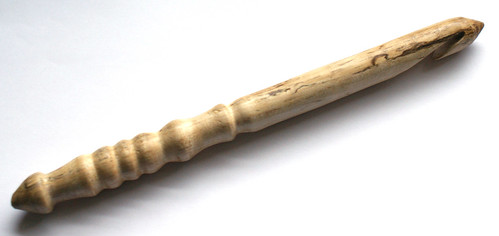
I’ve been meaning to make some rugs with random yarn or maybe old sheets. This is a large hook, I don’t know what size, but the knitting needle equivalent would probably be 35. Jumbo. Not the super biggest, hefty.
Danny shears off the belly wool & tags, lower legs, etc, then shears it all off in one piece, the traditional way. I think next year, with the covered fleeces (assuming that plan pans out…), I might ask him to him shear off everything that wasn’t covered, grab it up, then shear the blanket all in one piece. Then I can avoid skirting for the prime stuff, then fish through all the seconds later, skirting out the junk, then combining everything else from all the sheep into one big melting pot Cupcake Ranch Roving!
This time, we rolled up the fleeces as we went in old bedsheets, then later on we brought them inside and skirted and watched True Blood. All the skirted stuff is pretty rife with VM (my sheep are pigs and apparently like to burrow into the hay as much as eat it), so it’s just going to be mulch this year. Next year, I’m planning for blankets plus a cleaner feeding system (maybe just a big rack near the ground). With their hanging racks, they mash their heads deep into the hay, grinding all the seeds and tiny bits well into their neck fleece, which is still really nice fleece otherwise.
Danny did a great job, and he & Marilyn were really helpful. They go all over the place and service a lot of the small spinners’ flocks in the span of a couple states. We talked about goat milk and cheesemaking and Marilyn even brought me some lovely fresh goat’s milk, which I made into whole milk ricotta, and I gave her a copy of Goats Produce, Too! and some yogurt culture.
Here’s everyone before & after, plus their fleeces. I hope to weigh them this week & I’ll add the weights. In the meantime, I’ll include my guesses.
Agnes:

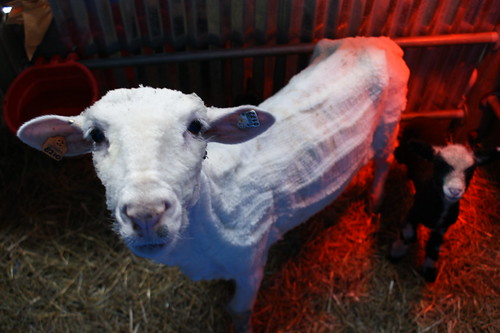
Agnes’ fleece (first shearing–lambswool):

Agnes’ fleece got all jumbled up, so you can’t see the pristine bright white cut side. I’m guessing it’s about 5.5# skirted.
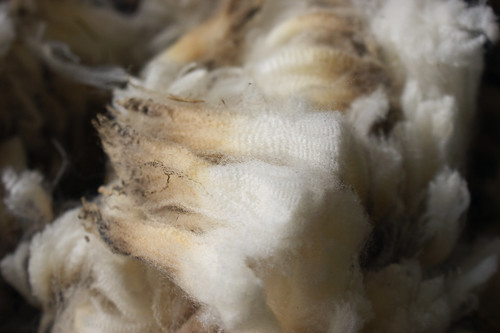
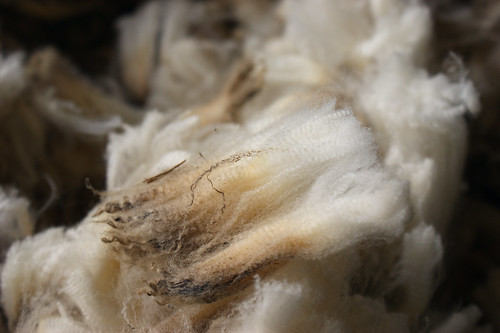
The average staple’s about 3.5″, not superlong, but not bad. It’s very soft, greasy and springy.
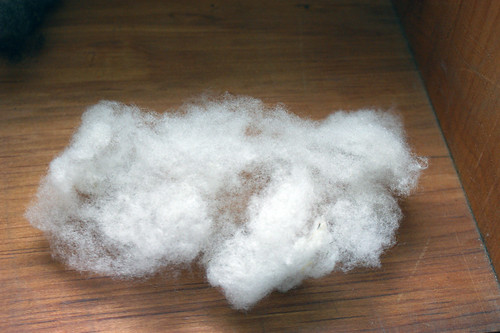
It washed up to a very bright white, super spongy and fluffy and bouncy!
Fudgy the Whale:
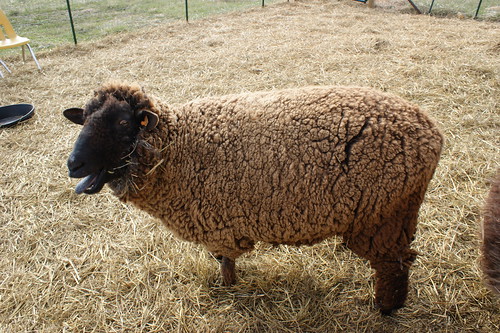
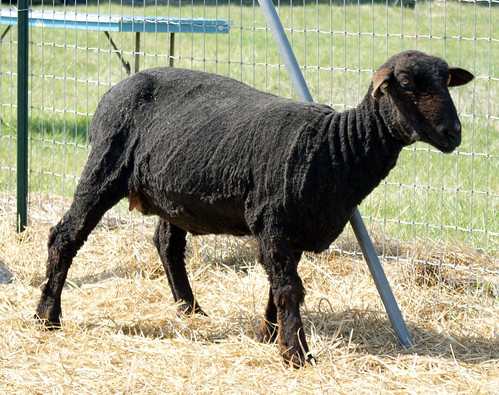
Fudgy’s fleece (2nd shearing–yearling):
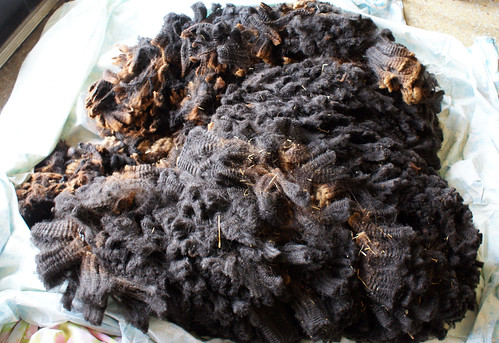
Fudgy’s fleece is the cleanest, probably because it’s so dense most of the crap just fell off the surface. I’m guessing 7# skirted.

It’s also the longest, averaging over 5″. Fudgy’s locks stick together in big chunks and fall apart in a really unsticky way. Whereas when you separate out a chunk of locks from the other fleeces, they’ll stick an lose some of their distinction, the Romeny ones are tight chunks of fiber with a really distinct lock formation, but all the chunks readily fall apart from all the other chunks. It’s hard to describe, almost like when you cube an avocado in the skin and it’s still all once piece, then you scoop it out from the skin as long, finished cubes? That sounds stupid. Anyway, it’s cool. And the color is just gorgeous, warm brown sun tips, and black to the skin, ranging from pure black to S&P.
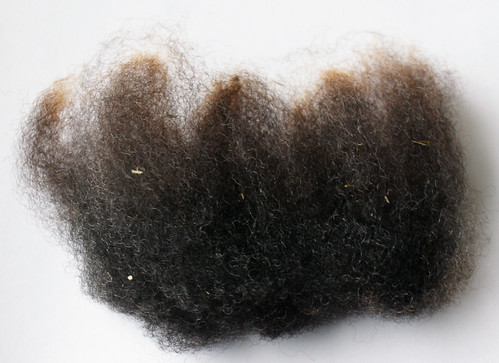
It washes up beautifully. I’m thinking I’ll combine this with her lamb fleece and get either roving or yarn. But which! I think it’s strong and long enough that it doesn’t need the extra step of combing. It’s also much cleaner than the other fleece.
Mr. Shivers:
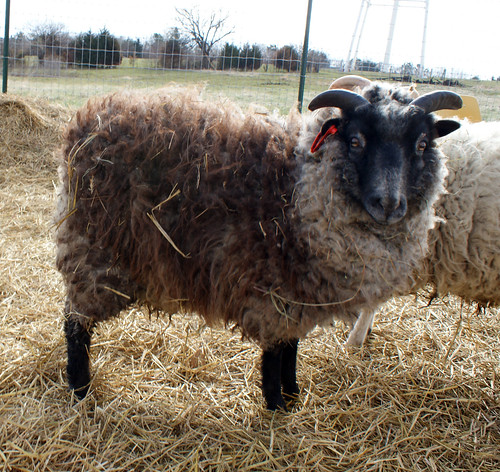

Sheared, you’d never expect the dark brown!
Mr. Shivers’ fleece:

Mr. Shivers’ fleece was definitely the most interesting. From the outside, it’s dark gray-brown, with a creamy mantle around his neck. From the inside, it ranges from a smoky gray to creamy white. The darker portion above shows the exterior of the fleece, and the interior, cut side is folded over so you can see the difference. I’m guessing maybe 3 or 4 pounds. The staple length is all over the place, ranging from 3″ for the downier stuff to 5 or 6 inches for longer outer coat.
While you can tell after he’s sheared that the inside colors will be much lighter and include gray (which is darker and more prominent along his spine, as you can see), there’s no hint that he’d have a light colored band around his neck (Bielset). Shetland markings have a specific traditional names, and Mr. Shivers gets a couple different ones. He gets Bielset for the ring around his neck, Sokket for his black stockings. And since some of the marking names can also mean the inverse (e.g., Bioget is white back with darker sides and belly, or conversely, black back with lighter sides and belly), he may also be Blaeget (lighter color on outer coat than undercoat; he’s the opposite).
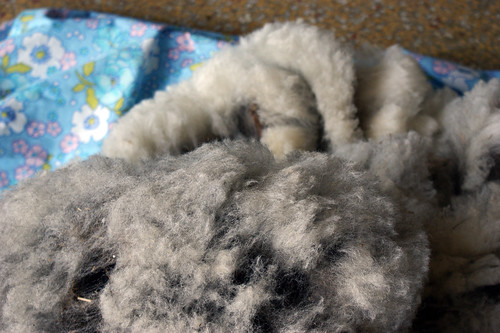
This shows the cut side of the fleece varies from white to gray.
Besides being variagated around his body, his fleece is also varigated within the fiber itself:
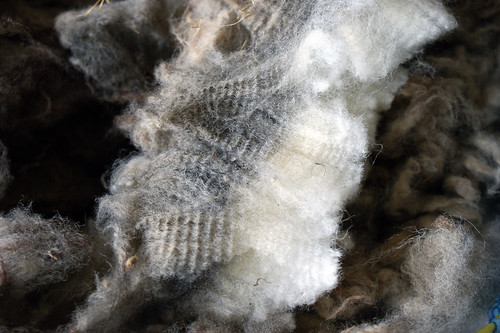
This lock starts white and goes to a steely blue-grey (the yellowy stuff is dirt; the gray’s much bluer than you see here).

Here’s a lock from near the spine with even darker gray, and some of the brown outer coat.

This lock shows a lot of the brown outer coat.

Here’s a lock washed up, the gray much bluer than I expected, and the brown darker! Even now, I still don’t get the double coated thing. At the base, the fibers look the same, but some terminate in long, dark tips. I think I expected it to be more like a dog’s undercoat, which is like soft bunny fur, and the outer coat, closer to human hair. This is all fleecy, but it’s more like two different breeds of fleece growing on the same animal.
Uncle Honeybunch:
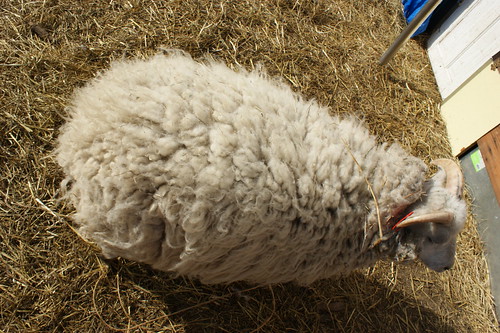

I think Uncle Honeybunch is a little fat. He looks heavier than everyone else. After shearing, the sheep don’t recognize each other and they all struggle for status again. The boys spent the first two days butting heads all day long, with Honeybunch occasionally trying to mount Fudgy, who is already knocked up, thank you very much. She’s also so much taller that he’d either need a step stool, or she’d need to kneel to make the math work. Also: Honeybunch is nutless. But I’m sure it was more a status game than a misguided attempt at breeding.
Uncle Honeybunch’s fleece:

I’m guessig about 3#, with staples ranging from 3 – 5″.

In both cases, you can see that the Shetland fleece is way looser an more open, almost like it’s already been washed (except that it’s still dirty!). It’s both fine and fluffy, but not so bouncy as the merino.
Washed, it’s bouncier and on Uncle Honeybunch’s fleece, the two lengths all blend together more. I don’t know whether that’s because he’s not as double-coated (if there ever are degrees of that?!) or because you just can’t see the distinction because it’s all the same color.

And here’s the whole gang!
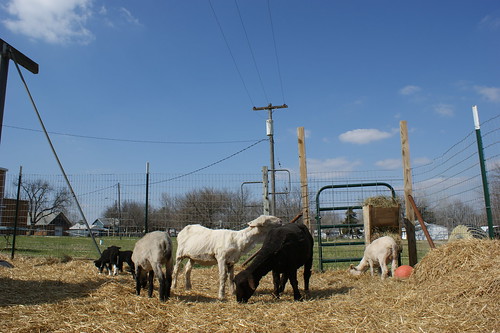
The babies are still getting penned at night and in foul weather, but they’re out and about all day when it’s sunny, and everyone’s getting along just fine.
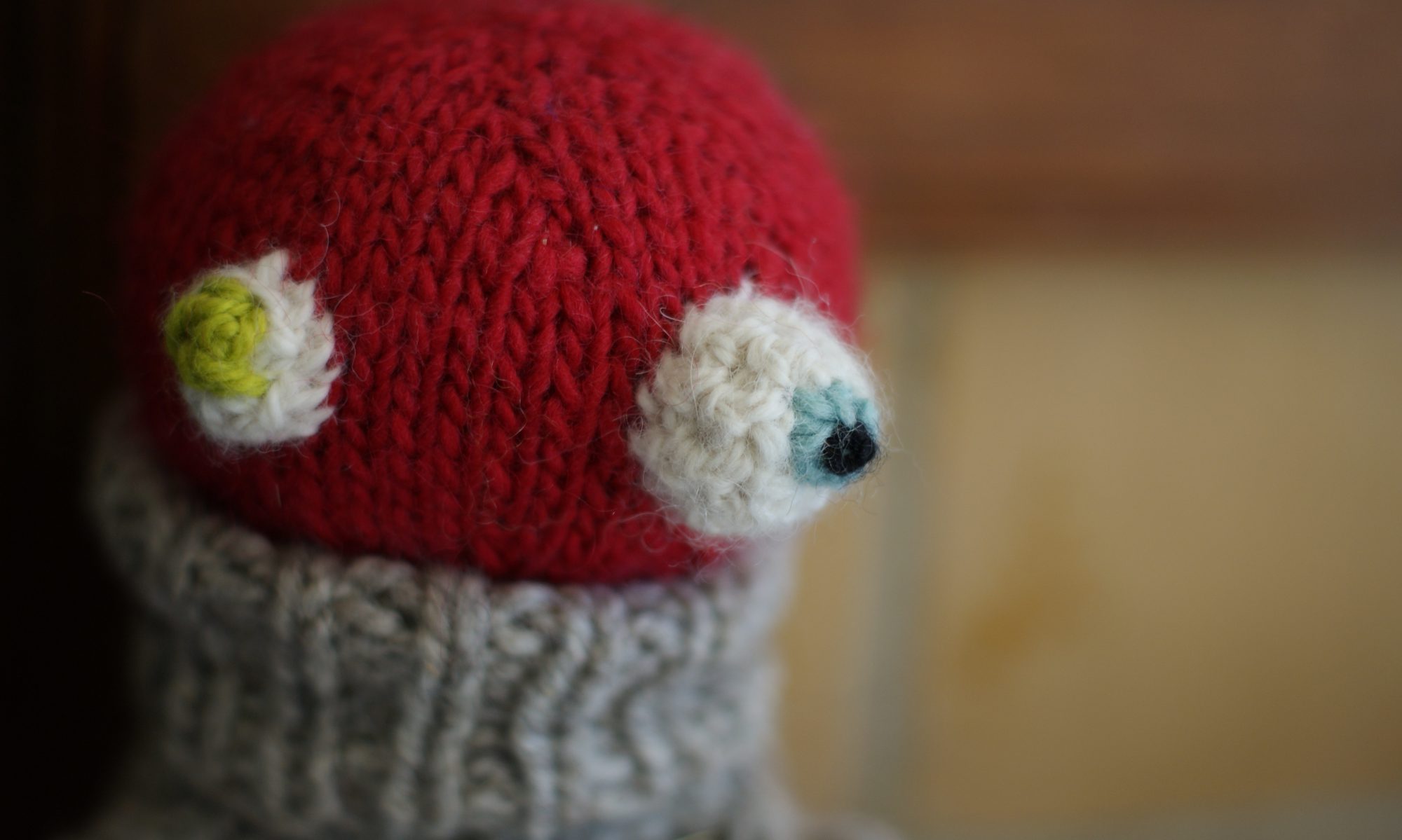
They are soooo cute!
“Gamboling” is the word that came to mind for that video. So cute they are!
Fascinating to see the differences in each fleece. Quite a long ways from anything in the LYS.
They are all gorgeous. It sounds like poor Honeybunch is rather confused. My dog has the same issues, but no spinnable fleece.
Thanks so much for sharing all of this information and the gorgeous pictures. You’re learning so much, on the job, the only way to really learn. When we were in Scotland, we stopped at sheep farm where we watched the farmer shear a sheep in one piece, using non-electric shears. Also, they raised shepherd dogs and one of the lambs had the same coloring as the shepherds, same color and markings and all of the other sheep stayed away from it for that reason – they associate it with the dogs. Beautiful job, Nikol.
Thanks so much for sharing the video and pics. I love the before and after pictures of all the sheep. They look so different. The lambs are adorable!